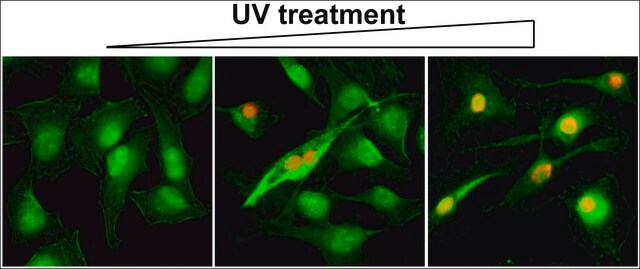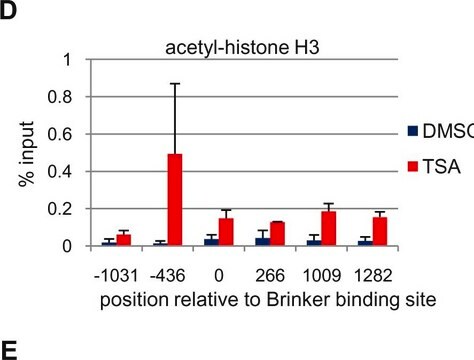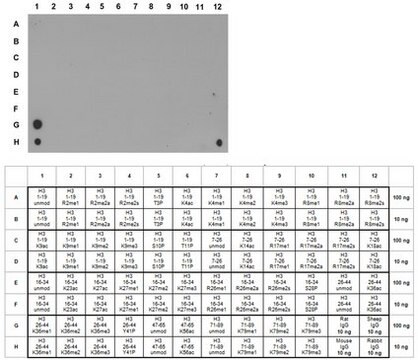04-835
Anti-dimethyl-Histone H3 (Lys79) Antibody, clone NL59, rabbit monoclonal
culture supernatant, clone NL59, Upstate®
Sinônimo(s):
H3K79me2, Histone H3 (di methyl K79)
About This Item
Produtos recomendados
fonte biológica
rabbit
Nível de qualidade
forma do anticorpo
culture supernatant
tipo de produto de anticorpo
primary antibodies
clone
NL59, monoclonal
reatividade de espécies
vertebrates, human
fabricante/nome comercial
Upstate®
técnica(s)
ChIP: suitable (ChIP-seq)
dot blot: suitable
multiplexing: suitable
western blot: suitable
Isotipo
IgG
nº de adesão NCBI
Condições de expedição
dry ice
modificação pós-traducional do alvo
dimethylation (Lys79)
Informações sobre genes
human ... H3F3B(3021)
Descrição geral
Especificidade
Imunogênio
Aplicação
Sonicated chromatin prepared from HeLa cells (1 X 10E6 cell equivalents per IP) were subjected to chromatin immunoprecipitation using either 4 µL of Negative Control Supernatant, or 4 µL of Anti-dimethyl-Histone H3 (Lys79) and the Magna ChIP A Kit (Cat. # 17-610). Successful immunoprecipitation of dimethyl-Histone H3 (Lys79) associated DNA fragments was verified by qPCR using Control Primers
Please refer to the EZ-Magna ChIP A (Cat. # 17-408) or EZ-ChIP (Cat. # 17-371) protocol for experimental details.
Chromatin Immunoprecipitation: A representative lot of this antibody has been shown by an independent laboratory to work in ChIP.
ChIP-Seq Analysis:
A representative lot of this antibody was used by an independent laboratory for ChIP-Seq. See Egelhofer, T.A., et al. (2011). See Easwaran, H., et al. (2012).See Suzuki, H., et al. (2011).
Dot Blotting: Specificity of a representative lot confirmed by the ability of a 1:2500 dilution of the antibody to recognize peptides corresponding to regions of histone H3 with various modifications
Dot Blot Analysis: Absurance Histone H3 Antibody Specificity Array (Cat. No. 16-667) and Absurance Histone H2A, H2B, H4 Antibody Specificity Array (Cat. No. 16-665), which contain histone peptides with various modifications were probed with Cat. No 04-835-S, Anti-dimethyl Histone H3 (Lys79) Antibody, clone NL59 (1:500 dilution). Proteins were visualized using a Donkey anti-rabbit IgG conjugated to HRP and a chemiluminescence detection system.
Epigenetics & Nuclear Function
Histones
Qualidade
Descrição-alvo
Ligação
forma física
Armazenamento e estabilidade
Handling Recommendations: Upon receipt, and prior to removing the cap, centrifuge the vial and gently mix the solution. Aliquot into microcentrifuge tubes and store at -20°C. Avoid repeated freeze/thaw cycles, which may damage IgG and affect product performance.
Informações legais
Exoneração de responsabilidade
Não está encontrando o produto certo?
Experimente o nosso Ferramenta de seleção de produtos.
Código de classe de armazenamento
10 - Combustible liquids
Classe de risco de água (WGK)
WGK 2
Certificados de análise (COA)
Busque Certificados de análise (COA) digitando o Número do Lote do produto. Os números de lote e remessa podem ser encontrados no rótulo de um produto após a palavra “Lot” ou “Batch”.
Já possui este produto?
Encontre a documentação dos produtos que você adquiriu recentemente na biblioteca de documentos.
Nossa equipe de cientistas tem experiência em todas as áreas de pesquisa, incluindo Life Sciences, ciência de materiais, síntese química, cromatografia, química analítica e muitas outras.
Entre em contato com a assistência técnica








